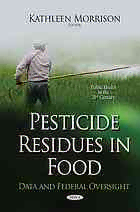
Pesticide residues in food : data and federal oversight PDF
Preview Pesticide residues in food : data and federal oversight
PUBLIC HEALTH IN THE 21ST CENTURY P R F ESTICIDE ESIDUES IN OOD D F O ATA AND EDERAL VERSIGHT No part of this digital document may be reproduced, stored in a retrieval system or transmitted in any form or by any means. The publisher has taken reasonable care in the preparation of this digital document, but makes no expressed or implied warranty of any kind and assumes no responsibility for any errors or omissions. No liability is assumed for incidental or consequential damages in connection with or arising out of information contained herein. This digital document is sold with the clear understanding that the publisher is not engaged in rendering legal, medical or any other professional services. P H 21 C UBLIC EALTH IN THE ST ENTURY Additional books in this series can be found on Nova’s website under the Series tab. Additional e-books in this series can be found on Nova’s website under the e-book tab. PUBLIC HEALTH IN THE 21ST CENTURY P R F ESTICIDE ESIDUES IN OOD D F O ATA AND EDERAL VERSIGHT KATHLEEN MORRISON EDITOR New York Copyright © 2015 by Nova Science Publishers, Inc. All rights reserved. No part of this book may be reproduced, stored in a retrieval system or transmitted in any form or by any means: electronic, electrostatic, magnetic, tape, mechanical photocopying, recording or otherwise without the written permission of the Publisher. For permission to use material from this book please contact us: [email protected] NOTICE TO THE READER The Publisher has taken reasonable care in the preparation of this book, but makes no expressed or implied warranty of any kind and assumes no responsibility for any errors or omissions. No liability is assumed for incidental or consequential damages in connection with or arising out of information contained in this book. The Publisher shall not be liable for any special, consequential, or exemplary damages resulting, in whole or in part, from the readers’ use of, or reliance upon, this material. Any parts of this book based on government reports are so indicated and copyright is claimed for those parts to the extent applicable to compilations of such works. Independent verification should be sought for any data, advice or recommendations contained in this book. In addition, no responsibility is assumed by the publisher for any injury and/or damage to persons or property arising from any methods, products, instructions, ideas or otherwise contained in this publication. This publication is designed to provide accurate and authoritative information with regard to the subject matter covered herein. It is sold with the clear understanding that the Publisher is not engaged in rendering legal or any other professional services. If legal or any other expert assistance is required, the services of a competent person should be sought. FROM A DECLARATION OF PARTICIPANTS JOINTLY ADOPTED BY A COMMITTEE OF THE AMERICAN BAR ASSOCIATION AND A COMMITTEE OF PUBLISHERS. Additional color graphics may be available in the e-book version of this book. Library of Congress Cataloging-in-Publication Data I SBN: (cid:28)(cid:26)(cid:27)(cid:16)(cid:20)(cid:16)(cid:25)(cid:22)(cid:23)(cid:27)(cid:21)(cid:16)(cid:21)(cid:28)(cid:22)(cid:16)(cid:19) (eBook) Published by Nova Science Publishers, Inc. † New York CONTENTS Preface vii Chapter 1 Food Safety: FDA and USDA Should Strengthen Pesticide Residue Monitoring Programs and Further Disclose Monitoring Limitations 1 United States Government Accountability Office Chapter 2 Agricultural Chemicals: USDA Could Enhance Pesticide and Fertilizer Usage Data, Improve Outreach, and Better Leverage Resources 95 United States Government Accountability Office Index 159 PREFACE This book examines what FDA data show with respect to pesticide residue violations in the foods that it regulates; what FSIS data show with respect to pesticide residue violations in the foods that it regulates; and what AMS data show with respect to pesticide residue levels in fruits and vegetables. Chapter 1 – From 1970 to 2007, hundreds of millions of pounds of pesticides were applied annually to U.S. food crops to protect them from pests. To protect consumers, EPA sets standards— known as tolerances—for pesticide residues on foods. FSIS monitors meat, poultry, and processed egg products to ensure they do not violate EPA’s tolerances, and FDA monitors other foods, including fruits and vegetables. AMS gathers annual residue data for highly consumed foods, although not for enforcement purposes. GAO was asked to review federal oversight of pesticide residues in food. This report examines (1) what FDA data show with respect to pesticide residue violations in the foods that it regulates; (2) what FSIS data show with respect to pesticide residue violations in the foods that it regulates; and (3) what AMS data show with respect to pesticide residue levels in fruits and vegetables. For each agency, GAO examined limitations, if any, in the agencies’ monitoring of foods for pesticide residues. GAO analyzed FDA, FSIS, and AMS pesticide residue data, including their reliability, reviewed agency methods for sampling foods for testing, and interviewed agency officials. Chapter 2 – The use of pesticides and fertilizers contributes to U.S. agricultural productivity and helps ensure a generally stable, plentiful, and inexpensive food supply. However, these chemicals may also harm human health, water quality, and food safety. The U.S. Department of Agriculture’s (USDA) National Agricultural Statistics Service (NASS) collects, analyzes, and disseminates Agricultural Chemical Usage (ACU) data to meet regulatory, viii Kathleen Morrison business, and other informational needs. In fiscal years 2007 through 2009, NASS substantially scaled back the ACU program before restoring it in 2010. GAO was asked to examine (1) what factors NASS considered in reducing the ACU program; (2) how ACU data users were affected by the temporary cutback, and their views on the data’s quality and usefulness; and (3) the extent to which agricultural pesticide and fertilizer usage data are available from sources other than NASS. GAO reviewed relevant NASS documents and interviewed NASS officials as well as 25 selected ACU data users.
